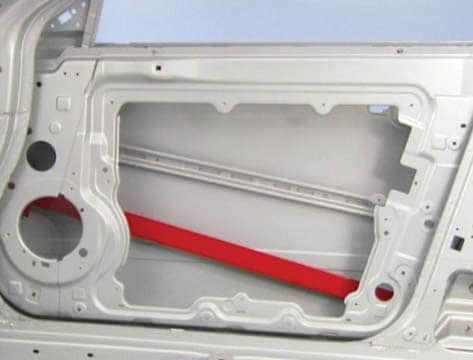Our vehicles are engineered to help protect passengers from injury in the event of a collision. Important structural safety features and concepts to understand include:
Zone Body Construction
When a crash happens, crumple zones and a reinforced passenger cabin help protect vehicle occupants. Crumple zones allow portions of the body to deform, dissipating impact energy. A reinforced passenger cabin resists deforming, helping protect occupants inside the cabin.
Although crumple zones and a reinforced passenger compartment have been important aspects of impact safety engineering within the automotive industry for years, Zone Body Construction was developed as an evolution of body construction design and takes safety to the next level. It optimizes vehicle structural design and material selection.
The technology involved in Zone Body Construction is unique to all of our vehicles. Depending on the vehicle platform, Zone Body Construction may incorporate a variety of different features, including:
-Double floor panels
-A double engine-compartment bulkhead
-Large section side sills
-Laser-welded roof and side panels
-Reinforced side structure members
-High-strength steels that vary in thickness depending on the area of the body in which they are applied
Zone Body Construction divides the vehicle into three zones: a front crumple zone, a reinforced passenger cabin, and a rear crumple zone.
-The front crumple zone helps protect occupants in both offset and full overlap (head-on) front collisions. Structural members and crossmembers deform to absorb crash energy.
-To protect occupants in the event of a side-impact collision, the vehicles have reinforced side roof rails and roof pillars. In addition, high-strength steel or high-strength aluminum side-door guard beams and innovative door shapes and construction help absorb crash energy. A-, B-, and C-pillars reinforced with ultra-high-strength steel are used to frame out these side-impact-absorbing components.
-The rear crumple zone is designed to help protect occupants in a rear-end collision. Once again, structural members and crossmembers deform to absorb crash energy
Crumple Zones
A single-impact collision can take less than two-tenths of a second from start to finish. Thatâ??s about the time it takes to blink your eyes. In this brief time, all the energy from the moving car must be dissipated, resulting in the bending of metal and stretching or deforming of various vehicle parts.
-Front and rear crumple zones help absorb impact energy, reducing the risk of injury to passengers by helping to maintain passenger compartment structural integrity.
-A crease in the hood reinforcement structure - called a deformation point - allows the hood to buckle at a predetermined point, helping protect the passenger compartment.
-Hood safety stops provide anchor points on the cowl to restrict the rearward movement of the hood in the event of a frontal collision, helping prevent the hood from entering the passenger compartment.
-On most vehicles, the rear engine mount and/or the rear transmission mount are designed to break away, allowing the engine and transmission to drop down so they won't enter the passenger compartment.
-Also on most vehicles, the brake pedal is designed to move away from the driver to reduce the likelihood of ankle and foot injuries.
Double Engine-Compartment Bulkhead
Certain vehicles also feature a double engine-compartment bulkhead. The double bulkhead design provides a crushable zone that helps absorb impact energy in certain frontal impacts, which helps maintain passenger compartment structural integrity.
Energy-Absorbing Steering Column
The energy-absorbing steering column is designed to compress during certain frontal impacts, so it helps absorb impact energy - very much like a spring absorbs energy when compressed.
As a result, the energy-absorbing steering column helps reduce the risk of injury in certain frontal impacts.

No comments:
Post a Comment